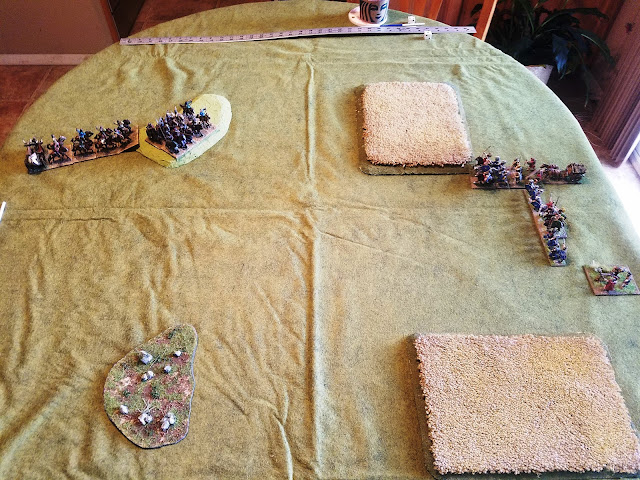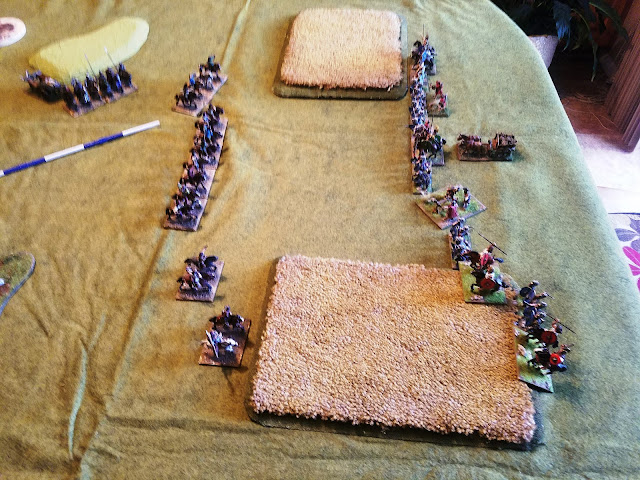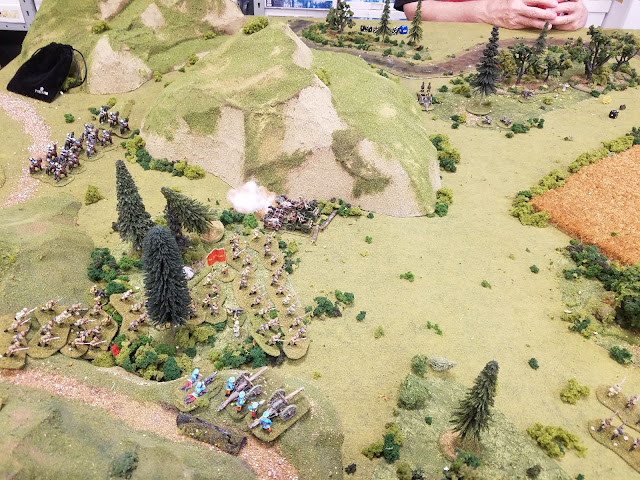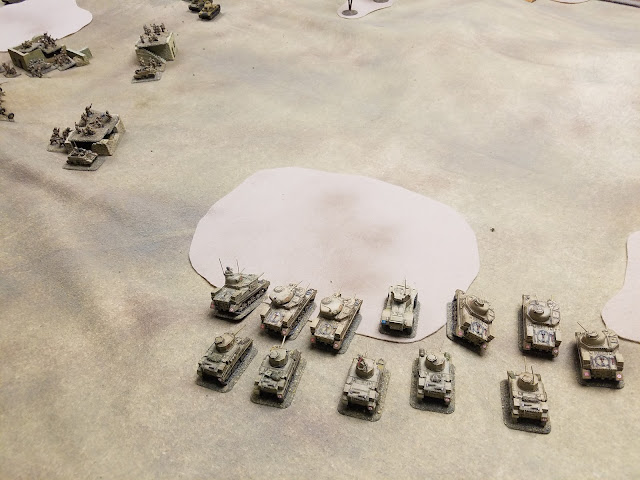We recently lifted our hiatus on gaming and tried a 12 element DBA 3.0 game combining the use of the "Collision Course" deployment variant and the "DBF" (De Bellis Fantasiae") playtest rules.
"Collision Course" is a variant deployment where both armies have three marching columns of equal strength entering the board, the first column is entirely on the board, the second column has the lead element only at the owning players board edge, and the third column is waiting to enter on a later turn when the owning player has 4 pips to spend allowing the column to enter the board.
DBF is the proposed name for a new "big battle high fantasy" play-test rule-set from WRG, combining the DBA 3.0 rules engine, plus adding HOTT (Hordes of the Things) fantasy rules & elements, along with some additional experimental rules. The play-test rules and the "Collision Course" deployment rules are available on the "DBA & HOTT Wargaming" Facebook group page in the files section (the file named "DB-H" are the DBF playtest rules). We decided to play a historical battle using them with Parthians vs Marian Romans.
Some of the changes DBF makes to DBA 3.0 that we used in our game are listed below:
1. Point System: DBF uses a simple point system similar to HOTT's. Most elements average 2 AP (army points) each.
2. Big Battle: DBF considers any game using more than 24 AP per side a "big battle" game, which adds additional rules/options. Armies of certain size can have multiple generals and commands. Since our game both had armies of 25AP each, we were allowed to both have 1-2 generals and commands. We chose to use 1 general and 1 command for each army, even though this was technically a "big battle" game.
3. Subsequent Moves: In DBA 3.0, only Light Horse and Psiloi are allowed subsequent moves. In DBF if playing a "big Battle" game, ALL units have the capability of subsequent moves, though at extra cost and availability of "pips."
4. Breaking Off From Close Combat: DBF allows individual engaged elements faster than their opponent to disengage under certain circumstances.
5. Unit Quality: In a "big battle" game, optional unit quality rules can be used. We used unit quality to even the small army point disparity between the Romans and Parthians by elevating 2 of the Roman elements to "superior." Superior elements can re-roll a combat die of 2 or less. Inferior elements (which cost less) cause the owning player to re-roll combat dice of 5 or more.
6. Command Bonus: In a "big battle" game, the CinC's element is only allowed to add +1 to a combat roll once per game. However, the CinC has additional abilities if playing a larger big-battle game than we were playing.
7. Victory Conditions: DBF increases the victory threshold to eliminating 50% of your opponent's army or command's army point total. DBA's victory threshold was 33%. As a result, games tend to last longer as you have to defeat more of your opponent's elements to win the battle.
8. Flank Marches, Ambush, & Hidden Deployment: We did not use these because they conflict somewhat with the Collision Course variant.
The Forces (based on the DBA 3.0 Army Lists):
Parthians:
10 x LH (Horse Archers)
2 x 4Kn (Cataphracts mounted 3/base)
Total: 25 AP (Army Points)
Marian Romans:
1 x Cav (CinC, Superior Cav)
1 x Cav (Gallic Auxiliary Cav)
4 x 4Bd (Legionaries)
1 x 4Bd (Superior Veteran Legionaries)
1 x Art (Bolt Shooter)
1 x 3Ax (Thracian Javelinmen)
2 x LH (Javelin Light Horse)
1 x Ps (Archers)
Total: 25 AP
The Battle:
The game was played on a 4' x 4' board, the largest allowed for regular DBA in 28mm. Both armies home terrain is arable at this time (about 53 BC). The Romans were the defenders and one terrain feature ended up in each quarter. The Parthians entered on the left. Collision Course deployment restricts terrain from being placed near the center of each board edge. In the photo above shows the starting positions of both sides. Each side has a mobile baggage element instead of a fixed camp.
The Parthian 3rd column (bottom left) has now entered the board while the Romans have deployed their 2nd column.
The Parthians are advancing their 2nd & 3rd columns of horse archers. The Roman 3rd column has arrived on the board on the right.
The Parthian 3rd column advances towards the Roman left flank while the Parthian 2nd column deploys into line. The Romans deploy their light cavalry with legionaries supporting.
The Parthians have lost an element to the bolt shooter. Another flees to the rear.
Another Parthian horse archer is lost to the bolt shooter. The Roman light horse supported by the legionaries recoil the other Parthians.
The Parthian cataphracts come down off the hill.
The Parthians charge the center of the Roman line, successfully taking out the bolt shooter and recoiling a legionary element.
The Parthian cataphracts destroy 2 legionary elements. The Parthian horse archers have another legionary element flanked.
A closeup view of the action.
The Roman CinC's Cavalry element dies in close combat, even with a re-roll (he already used his +1 earlier). The CinC cataphract element wheels into the Thracian flank, though the other cataphract element is lost. The legionary element flanked the previous turn is destroyed. The center of the Roman line is broken.
The battle lasted longer than a typical DBA 3.0 game, due to the Collision Course and DBF rules. The Collision Course variant is definitely an interesting alternative to deployment. The point system is simple and easy to use. We were able to easily convert existing DBA army lists to AP's, then balance the armies using unit quality. We both used subsequent moves at various times, which was a nice change. There were no attempts to break-off from combat, though that was always an option, especially for light horse.
As far as the armies were concerned, the Parthians chose to have only a couple cataphract elements and more light horse and maneuverability when they could have had a larger percentage of cataphracts. The Romans chose an army with more cavalry and a bolt shooter, which is definitely effective vs light horse.
UPDATE 09/27/2023: I have been informed that the DBF play-test rules and the DB-H rules on the DBA & HOTT Facebook Group are two different documents, so my error in assuming they were related. The game played above used the DB-H rules that combined DBA 3.0 with HOTT, plus some optional rules.







































































